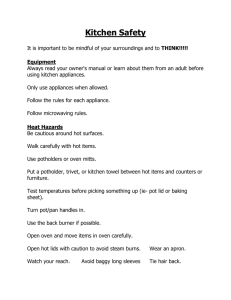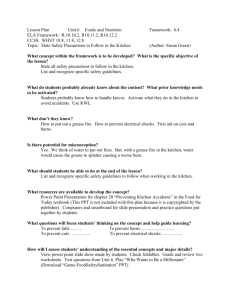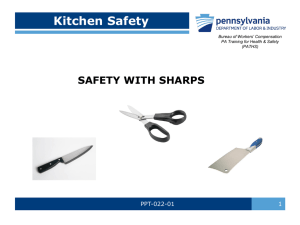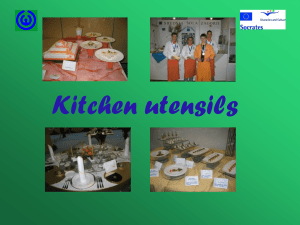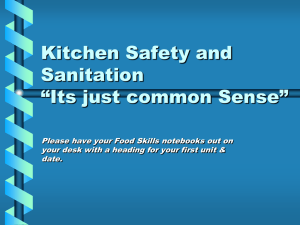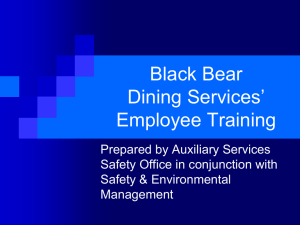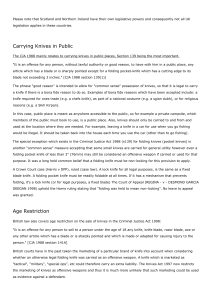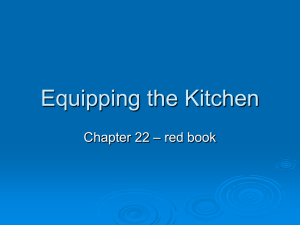Health and Safety Exam Q & A
advertisement
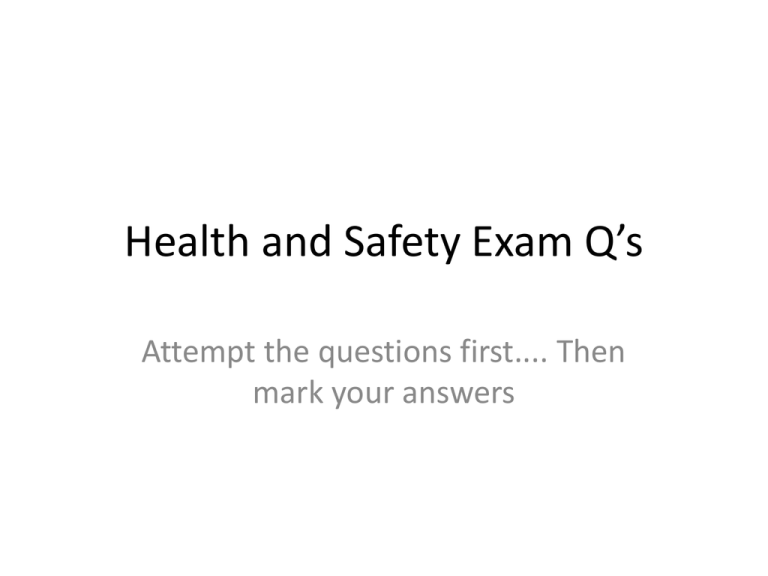
Health and Safety Exam Q’s Attempt the questions first.... Then mark your answers Answer the following questions: 5. Cross or tick the following statements to say if they are true ()or false (x). (5) (i) Never run in the kitchen (ii) Always use a damp tea towel to handle hot equipment (iii) Cover minor cuts with a blue waterproof dressing (iv) Always use a blunt knife (v) Burns are caused by dry heat 6. What is the first aid treatment for (a) A small cut (2) (b) A minor burn (2) 7. Safe working in the kitchen is important. (a) State two aims of the Health and Safety at Work Act. (2) (b) Identify the major causes of accidents in a commercial kitchen. (4) (c) Discuss ways in which accidents in the catering kitchen can be avoided. (6) Mark your answers: Answers Mark out of 21 5. (i) Never run in the kitchen () (1) (ii) Always use a damp tea towel to handle hot equipment (x) (1) (iii) Cover minor cuts with a blue waterproof dressing () (1) (iv) Always use a blunt knife (x) (1) (v) Burns are caused by dry heat () (1) 6. (a) Wash, dry, apply blue waterproof dressing/plaster. If it bleeds persistently apply pressure. (2) (b) Run under running cold water for 10mins or until stinging stops. For fat burns seek medical help. (2) 7. (a) increase awareness of safety at work, make sure employers are protected by law, make sure employees are protected by law, provide supervision information and training. (2) (b) Slips, trips, falls, burns and scalds, lifting heavy objects incorrectly, misuse of electrical equipment, lack of attention. (4) (c) Answer to include reference to: floors in good repair; warning notices of wet floor; guards on machinery; extra care cleaning machinery; one person to a machine; dry cloths to handle hot dishes; lift heavy items correctly; never place knives in sinks; use knives correctly with care; don’t overload sockets; don’t have trailing wires; don’t handle electrical equipment with wet hands; walk not run. (6) Questions Accidents, Hazards, Fire, First Aid (a) Answer the following questions: 1.(a) Give three details that must be included on an accident form. (3) (b) List three types of accidents that occur in a catering kitchen. (3) (c) Explain how accidents can be prevented in a catering kitchen. (5) 2. (a) Give four safety rules to follow when using knives. (4) (b) How would you treat a cut from a sharp knife? (2) 3. (a) List three safety points that must be considered when using a deep fat fryer. (3) (b) State two actions that you would take if a deep fat fryer caught fire. (2) (c) A member of the kitchen brigade has a hot fat burn on the hand. Describe how you would treat the burn. (3) 4. Hazards in a catering kitchen can cause accidents. Complete the following chart, identifying the action that should be taken to prevent an accident. (4) (i) A wet floor (ii) Worn or damages flex on an electrical mixer (iii) Misuse of equipment (iv) Boxes or cartons left on the floor Answers Mark your answers: Mark out of 29 1.(a) Gender, time, date, place of accident, type of accident, treatment given, further treatment, supervisor, witness, whether worker was doing his/her job. (3) (b) Cuts, burns, scalds, falls, trips, electric shocks, incorrect lifting of heavy objects. (3) (c) Answer to include reference to: floors in good repair; warning notices of wet floor; guards on machinery; extra care cleaning machinery; one person to a machine; dry cloths to handle hot dishes; lift heavy items correctly; never place knives in sinks; use knives correctly with care; don’t overload sockets; don’t have trailing wires; don’t handle electrical equipment with wet hands; walk not run. (5) 2. (a) Use a sharp knife; use correct size of knife; keep handles grease free; carry knives pointing down; never put knives in the sink; keep knives away from surface edge; never catch a falling knife, store knives in knife block. (4) (b) wash, dry, apply a blue waterproof plaster/dressing. If it bleeds persistently apply pressure. (2) 3. (a) Don’t overload fryer, don’t place wet items into oil, choose correct cooking temperature, add food slowly, (3) (b) Switch off appliance, switch off gas, cover with fire blanket, raise fire alarm, follow fire procedure (2) (c) place burn under water/immerse in cold water, keep there for 10mins, if serious cover with dressing, apply cling film (3) 4. (i) A wet floor sign, mop immediately (1) (ii) replace wire/flex, don’t use, inform manager/electrician (1) (iii) staff training, being instructed (1) (iv) supervised delivery, move to correct storage area (1)
